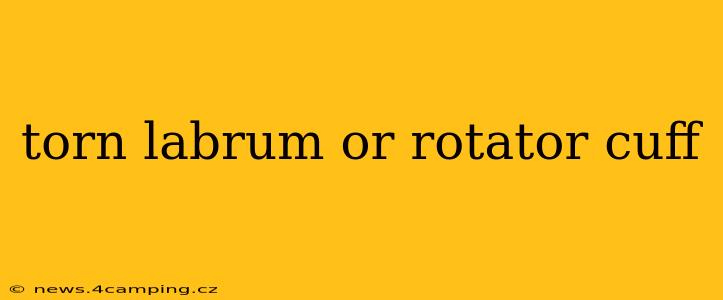Shoulder pain is a common ailment, often stemming from injuries to the labrum or rotator cuff. While both structures reside in the shoulder joint and contribute to its stability and movement, they differ significantly in their function and the types of injuries they sustain. This comprehensive guide will clarify the distinctions between a torn labrum and a rotator cuff injury, helping you understand the symptoms, diagnosis, and treatment options for each.
What is a Labrum Tear?
The labrum is a ring of cartilage that lines the shoulder socket, deepening it and providing stability to the shoulder joint. A labrum tear occurs when this cartilage is damaged, often through sudden trauma like a fall or a forceful twisting motion. It can also develop gradually due to repetitive overhead activities or overuse. Think of the labrum as a gasket ensuring a tight seal between the ball (humeral head) and the socket (glenoid). When torn, this seal is compromised, leading to instability and pain.
What is a Rotator Cuff Tear?
The rotator cuff is a group of four muscles and their tendons that surround the shoulder joint. These muscles—supraspinatus, infraspinatus, teres minor, and subscapularis—work together to enable a wide range of motion and provide strength and stability. A rotator cuff tear involves damage to one or more of these tendons, often caused by sudden forceful movements, falls, or repetitive strain. Unlike the labrum, which is primarily a stabilizing structure, the rotator cuff is responsible for the actual movement of the shoulder.
What are the Symptoms of a Torn Labrum?
Symptoms of a labrum tear can vary, depending on the size and location of the tear. Common symptoms include:
- Clicking or popping sensation: in the shoulder during movement.
- Shoulder pain: ranging from mild to severe, often worsened with certain activities.
- Shoulder instability: a feeling of the shoulder "giving way" or slipping out of place.
- Limited range of motion: difficulty performing certain movements.
- Pain at night: particularly when sleeping on the affected side.
What are the Symptoms of a Rotator Cuff Tear?
Rotator cuff tears present with a distinct set of symptoms:
- Shoulder pain: particularly when lifting or reaching overhead.
- Weakness: difficulty lifting or rotating the arm.
- Limited range of motion: making everyday tasks challenging.
- Stiffness: restricted mobility in the shoulder joint.
- Night pain: similar to labrum tears, sleeping on the affected side can be uncomfortable.
How are Labrum Tears Diagnosed?
Diagnosing a labrum tear typically involves a physical examination by a doctor, who will assess your range of motion and check for any instability. Imaging techniques like MRI and arthroscopy are often used to confirm the diagnosis and determine the extent of the tear.
How are Rotator Cuff Tears Diagnosed?
Similar to labrum tears, a physical exam is crucial for diagnosing a rotator cuff tear. Imaging tests such as X-rays, MRI scans, and ultrasound are used to identify the location and severity of the tear. The doctor may also conduct specific tests to assess the strength and function of the rotator cuff muscles.
Can a Labrum Tear and Rotator Cuff Tear Occur Together?
Yes, it is possible to have both a labrum tear and a rotator cuff tear simultaneously. Such injuries often result from the same traumatic event or chronic overuse. Accurate diagnosis is vital to determine the extent of damage to both structures and to formulate the appropriate treatment plan.
What are the Treatment Options for a Torn Labrum?
Treatment for a labrum tear depends on the severity of the tear and the individual's symptoms. Options include:
- Conservative treatment: rest, ice, physical therapy, and pain medication.
- Surgical repair: arthroscopic surgery is a common minimally invasive procedure to repair the tear.
What are the Treatment Options for a Rotator Cuff Tear?
Treatment options for a rotator cuff tear also depend on severity and symptoms:
- Conservative treatment: rest, ice, physical therapy, and anti-inflammatory medications.
- Surgical repair: depending on the size and location of the tear, surgery might be necessary to repair the torn tendon.
How Long Does it Take to Recover from a Labrum Tear?
Recovery time from a labrum tear varies depending on the severity of the tear and the chosen treatment approach. Conservative treatment may take several weeks to months, while surgical repair typically requires a longer recovery period of several months.
How Long Does it Take to Recover from a Rotator Cuff Tear?
Similar to labrum tears, recovery time from a rotator cuff tear is variable. Conservative management can take several weeks or months, while surgical repair can involve a recovery period of several months or even longer, depending on the extent of the injury and the individual's response to treatment.
This information is for general knowledge and should not be considered medical advice. Always consult a healthcare professional for diagnosis and treatment of any shoulder pain or injury. They can accurately assess your condition and recommend the most appropriate course of action for your specific situation.
